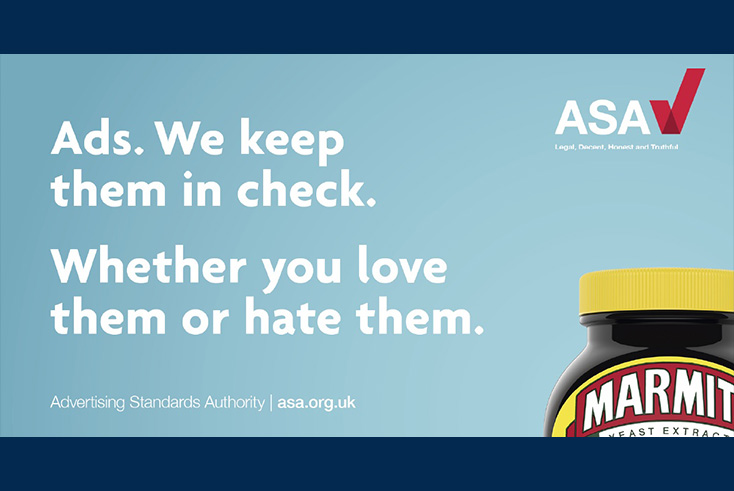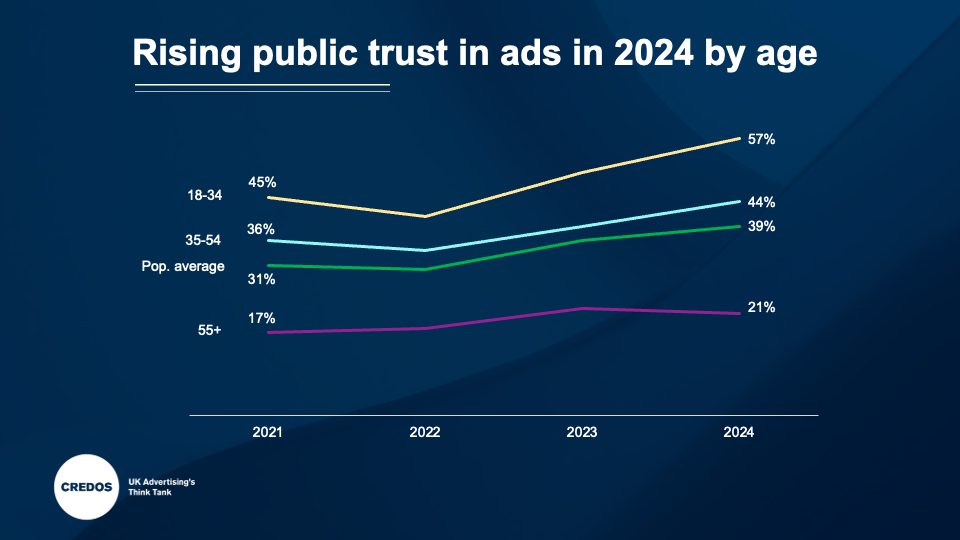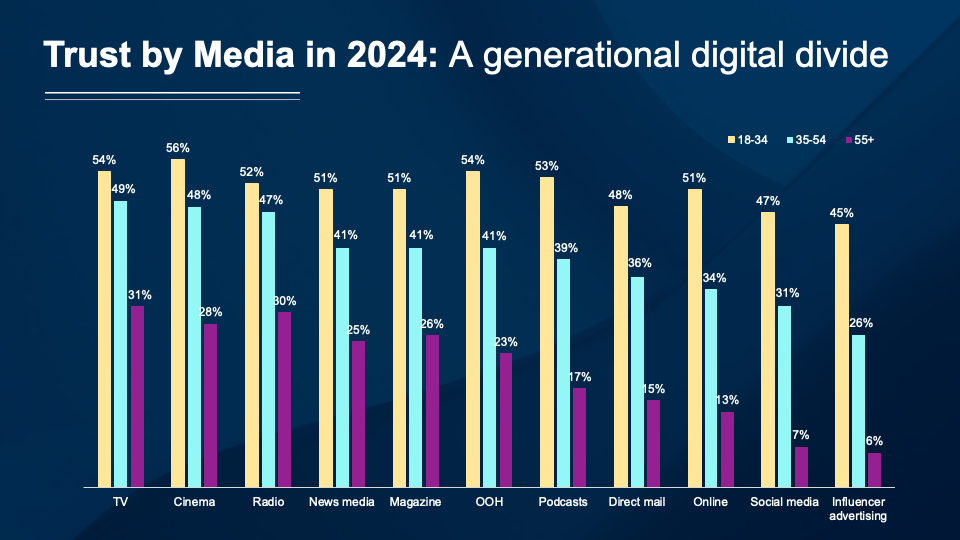Youth boosts public trust in advertising

Public trust in advertising rose from 36% to 39% in 2024, driven largely by increased trust from younger audiences.
That is according to the latest annual Trust Tracker survey from Credos, the UK’s advertising think tank, in partnership with the Advertising Association.
It found that, since 2022, trust in advertising has grown nine percentage points.
However, among 18- to 34-year-olds, the increase amounted to 16 percentage points, while it was only up three percentage points for over-55s.
Differing attitudes to media between demographics — particularly for online media — is driving “a significant contrast in the population”, according to Credos. Indeed, 18-34s are nearly three times more likely trust advertising than over-55s (57% versus 21%)— something that the think tank referred to as a “generational digital divide”.

Credos has previously found a strong positive correlation between the growing intergenerational trust gap and digital advertising’s share of total UK adspend.
“Everyone now aged 18-24 have grown up with access to Facebook, Google and other online platforms, causing a widening of the gap in trust between the young and old,” Advertising Association editor George Grant wrote in September.
He added: “To be clear, the trust gap is not just a result of the older generation trusting advertising less over time — it is also a reflection of the increasingly large section of young people who are comfortable with, and trusting of, new media formats.”
Factors driving trust across media channel
Despite the positive strides in public trust in advertising, trust in the ad industry itself ticked down slightly year on year from 30% to 29%. Trust in the industry was marginally overtaken by trust in media more generally (30%), as well as government (31%), following a change in leadership.
Other industries, such as energy (38%), telecoms (45%), and banking (54%), remain considerably more trusted by the public than advertising.
Still, for the second straight year, trust in all advertising media channels increased.
The most trusted channels remain TV and cinema (each trusted by 43% of people). These are followed by other traditional channels like radio, news and magazine media, and OOH.
While trust in online advertising channels remains lower, it continues to rise, especially among the young. For example, more than half of 18-34s said they trust online advertising (51%) and podcast advertising (53%). Meanwhile, 18-34s also have considerably higher trust in social media (47%) and influencer advertising (45%) than other cohorts.

“There are a number of factors that drove the overall increase in trust in 2024, including a strong festive ad season and more enjoyable advertising, with humour definitely making a comeback post-pandemic,” said Credos director Dan Wilks.
He noted that qualitative research conducted by Credos also found that many expressed improved ad experiences in some channels, particularly in broadcaster VOD and influencer marketing.
“Also having significant impact over this period is the Advertising Standards Authority (ASA) ad campaign, which ran for the third time in 2024,” Wilks pointed out.
“We know that increased public awareness of our co- and self-regulatory system has a positive effect on people’s trust in advertising.”
Last year, the Advertising Association and Credos found that not only has trust in advertising improved, but so has the perception that advertising “drives positive change in society”, with 44% of Brits surveyed agreeing with this sentiment. In 2021, this figure was 34%.
Building on ASA campaign
The ASA’s national, multichannel awareness campaign last ran for eight weeks from September. According to campaign research, over one-third (36%) of UK adults recalled seeing or hearing the ASA ads and those who were exposed to the ads were found to be more than twice as likely to trust the ad industry.
Advertising Association CEO Stephen Woodford said he was “pleased” with the latest Credos results and suggested that the ASA campaign has acted as an important initiative for improving public opinion of the industry.
“The ASA campaign is clearly a key lever we can pull and we are again incredibly grateful to the brands who lend us their famous assets and straplines; to Leith and EssenceMediacom, who are so generous with their creative and media expertise; and to the media owners who donate,” he said.
Woodford added that the organisation “plan[s] to build on this in 2025”.




